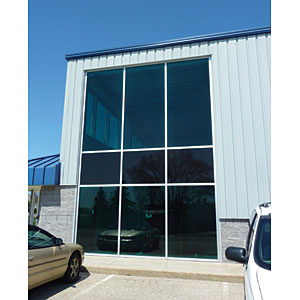The Federal Government’s General Services Administration owns and leases over 350 million square feet of office space—nearly 10,000 buildings, housing more than a million federal employees. It oversees $66 billion of procurement annually and contributes to the management of about $500 billion in U.S. federal property. GSA is the nation’s largest commercial office landlord—more than twice the size of GE Captial Real Estate (with global total of 160 million square feet), and nearly three times that of CB Richard Ellis Investors portfolio (at 128 million square feet).

|
|
Images of a thermochromic window installation in action—an example of one of the green building technologies currently installed and being tested under the GSA Green Proving Ground Program. Image on left shows the glazing as it appears when not activated. Image shows how the glazing darkens when exposed to direct sunlight, automatically reducing solar heat gain. |
$66 billion of procurement annually and contributes to the management of about $500 billion in U.S. federal property. GSA is the nation’s largest commercial office landlord—more than twice the size of GE Captial Real Estate (with global total of 160 million square feet), and nearly three times that of CB Richard Ellis Investors portfolio (at 128 million square feet).
GSA touts its long commitment to energy use reduction in buildings since the installation of a green roof on one of its buildings way back in 1975, over a below-grade parking structure connected to the Edith Green/Wendell Wyatt Federal Building in Portland, Oregon. The roof has exceeded the average life expectancy with over 35 years of service without a leak or repair. Today, GSA proudly reports it has more than 1 million square feet of green roofs installed on its buildings. In addition to GSA’s green roof initiative it has launched several others over the years including a renewable energy purchase program (1991), a green cleaning products program (1995), and a sustainable design program (1999).
As awareness and concern about the environment continues to grow, GSA’s commitment to reducing its impact has grown as well, with a surprising degree of urgency and aggressiveness. Remarks made in 2010 by the then GSA Administrator Martha Johnson at a USGBC Federal Summit underscore this point poignantly:
“… GSA is a fulcrum for the government’s sustainable performance. We can leverage our massive buying power to impact the government’s environmental footprint. We are broad, so we shouldn’t—and don’t have to—limit ourselves to marginal or incremental change.
“… Within this context, we at GSA are embracing a zero environmental footprint goal. We are setting our sights on eliminating the impact of the federal government on our natural environment. Yes, you heard it correctly. The word is “eliminate” not “limit.” I’m not kidding. Zero environmental footprint.
“… [W]e must reinvent the notion of risk-taking. We must be willing to fail, and fail fast, and fail fruitfully. We need to be able to win some quickly, lose some quickly, learn from our mistakes, and then share our successes and failures with partners such as USGBC. GSA is big enough to tolerate more risk. We can, as Public Buildings Service Commissioner Bob Peck puts it, be the green proving ground.”
And with that, the GSA’s Green Proving Ground Program was launched.
GREEN PROVING GROUND PROGRAM
With the introduction of GSA’s GPG Program, it is moving way beyond green roofs, compact fluorescent light bulbs, and waterless urinals. The program is designed to leverage GSAs massive influence and buying power to “test and evaluate innovative and underutilized sustainable building technologies and practices.” This is both exciting and scary. Exciting because of the possibility of identifying and evaluating new technologies that work really well in greening our buildings. Scary because the program is designed to allow it, in Martha’s words, “to fail, and fail fast, and fail fruitfully.” Taxpayers might not be as willing to risk everything on a throw of the dice, and GSA risks even more negative public and congressional reaction if the program ends up failing fast and fruitfully.
In 2010 GSA requested information for new and underutilized green building technologies to be tested and evaluated in GSA buildings. Sixteen were selected and are currently installed and being monitored. GSA has since released GPG Program requests annually, the most current having closed Nov 23, 2012. To be selected, proposers of innovative products can either unconditionally gift the technology to the GSA or provide the technology for testing with payment of a fee to GSA.
- The review process uses seven equally weighted evaluation criteria
- Degree to which the technology or practice is innovative or underutilized
- Potential to be widely deployed
- Ability to provide practical data needed to measure results and/or outcomes
- Ability to establish quality baselines in a timely manner
- Probability of success commensurate with projected risk
- Wide deployment likely to be life-cycle cost effective
- Availability on the market
Measurement and verification, performed by National laboratory staff, is used to verify the performance if the incorporated technologies and lasts from 4-12 months. Associated savings are calculated and evaluated to “inform GSA’s technology performance specifications and future practices.” If the technology works, is easy to acquire, install and implement, and saves energy and money—expect to see it as a GSA requirement for future buildings.
RESULTS TRICKLING IN
GSA has begun publishing results from its earliest GPG Program technologies that have been installed and monitored in actual buildings. On the GPG Program website there are three Technology Assessments available; Occupant Responsive Lighting, Plug Load Control, and Wireless Sensor Networks. Each assessment is presented in a generally consistent, easily readable format that includes a description of the technology tested, what was measured, the results of the implementation, and a recommendation for deployment of the technology throughout GSA’s portfolio.
CONCLUSION
Early assessment results offer an encouraging look into a program that might prove to be very successful. We won’t know for certain, however, until more assessments are made. Other technologies deployed, or scheduled to be deployed, include more exotic systems such as chilled beams, PV/Solar water heating panels, and ground-source heat pumps that could very well fall into the “fruitful failure” category. If failure results in better information, I am all for it. We all too often look to the sexy, complicated, exotic, expensive, and marginally (if at all) energy savings strategies first—without knowing much at all about their actual impact. I am hopeful that the GPG Program will be successful in redirecting focus to more accessible, less costly, highly energy efficient systems that can be broadly deployed not only in federal facilities but all buildings. This is one program that shows real promise as a tool that can be used in removing risk and saving energy. W&C
A BIG THREE
A quick and dirty summary of three GPG Program technologies:
Technology: Occupant Responsive Lighting Systems - Retrofit
Significant Energy Savings: Annual savings by site ranging from 27 to 63 percent, as little as 7 year payback period.
Recommendation: Limited deployment recommended for offices with 3-tube 2x4 troffer light fixtures, operating 14 hours/day or longer, with utility costs of $0.11/kWh or greater, and an occupancy pattern that is variable.
Technology: Plug Load Control – Advanced Power Strips
Significant Energy Savings: Plug load reduction ranging from 26 to 50 percent with a payback period of less than eight years for all applications.
Recommendation: Limited deployment recommended for plug loads for equipment that (1) is used on a predictable schedule, and (2) is left powered on during non-business hours, weekends, and holidays.
Technology: Wireless Sensor Networks – Data Center in Missouri
Significant Energy Savings: 17 percent reduction in total data center power usage, resulting in a cost savings of $30,000 per year and a 3.4 year payback period.
Recommendation: Broad deployment recommended for federally operated data centers.










